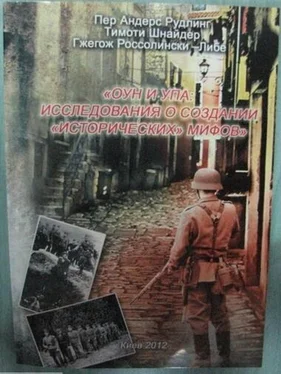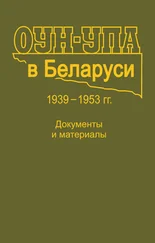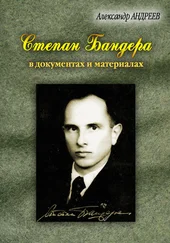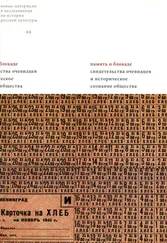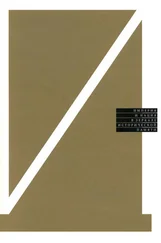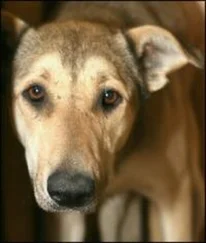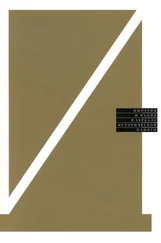Per A. Rudling, “Szkolenie w mordowaniu: Schutzmannschaft Battalion 201 i Hauptmann Roman Szuchewycz na Bia" orusi 1942 roku,” in Bogulaw Paz (ed.), Prawda historyczna a prawda polityczna w badaniach naukowych: Przyklad ludobójstwa na kresach po!udiowej-wschodniej Polski w latach 1939–1946, (Wroc" aw: Wydawnictwo uniwersytetu Wroc" awskiego, 2011), 183–204.
Bul’ba-Borovets, Armiia bez derzhavy, 254, citing “Vidkrytyi list da Chleniuv Provodu Orhanizatsii Ukrains’kykh Natsionalistiv Stepana Bandery,” Oborona Ukrainy: Chasopys’ Ukrains’koi Narodn’oi Revolutsiinoi Armii, Osoblyve vydannia ch. 1, August 10, 1943.
John-Paul Himka, Ukrainians, Jews and the Holocaust: Divergent Memories (Saskatoon: Heritage Press, University of Saskatchewan, 2009), 46; Kurylo and Khymka, “Iak OUN stavylosia do ievreiv?” 260.
Carynnyk, “Foes of Our Rebirth,” citing “Nakaz Ch. 2/43, Oblasnym, okruzhnym i povitovym providnykam do vykonannia,” TsDAVO, f. 3833, op. 1, spr. 43, l. 9.
Himka, Ukrainians, Jews, and the Holocaust, 46–47.
Document scan available on the website of the Embassy of Ukraine in Canada, http://www.ukremb.ca/canada/ua/news/detail/11684.htm (accessed January 18, 2011).
Volodymyr V’’iatrovych, Stavlennia OUN do ievreiv: formuvannia pozytsii na tli katastrofy (L’viv: Vydavnytstvo “MS”,2006), 73.
Kosyk adds Armenians, Lithuanians, Italians, Romanians, Hungarians, Germans, and Belgians. Kosyk, The Third Reich, 373–374. Some of these non-Ukrainian UPA participants appear to have been former Soviet POWs who had served as Schutzmänner but defected after Stalingrad, and other collaborators. U.S. intelligence also mentioned former members of the Slovak Hlinka Guard, former soldiers of the Ukrainian Waffen-SS division Galizien, but also “escaped German SS men.” Breitman and Goda, Hitler’s Shadow, 79, citing Preliminary Reports I and Informant Report 35520 [undated], National Archives and Records Administration, (henceforth NARA), RG 319, IRR TS “Banderist Activity Czechoslovakia,” v. 1, D. 190425.
“Through resurrection and sabotage we fi nally broke the strengths of the Muscovite-Jewish [moskovs’ko-zhydovskyi] occupant. When the war fi nally broke his physical extermination and and our rise under the leadership of our leader Stepan BANDERA.” Leafl et distributed in June 1942 on the occasion of the fi rst anniversary of the Act of June 30, 1941. HDA SBU, f. 13, spr. 372, ch. 35, l. 200. On 1947, see f. 13, op. 376, tom 4, l. 363. On 1948, see f. 13, op. 376, tom 65, l. 243.
“To the brotherly Czech and Slovak nations,” in Petro J. Potichnyj, ed., English Langauge Publications of the Ukrainian Underground, Litopys UPA, 17 (Toronto: Litopys UPA, 1988), 158.
For instance, an underground OUN(b) journal from 1946 describes the History of the VKP(b) as the “Bolshevik Talmud.” Ukrains’kyi robitnyk: Vydaie kraiovyi oseredok propahandy OUN, No.1. (January 1946): 2.
Anna Holian, “Anticommunism in the Streets: Refugee Politics in Cold War Germany,” Journal of Contemporary History, 45, no. 1 (2010): 144.
Ibid., 147–148.
“Evrei — hromadiane Ukrainy,” OUN(b)-UPA leafl et written in March 1950, HDA SBU, f. 13, d. 376, tom 65, ll. 283–294.
Ibid., l. 293.
“Protokol doprosa obviniaemo Okhrimovucha Vasilia Ostapovicha ot 5 ianvaria 1953 g.,” HDA SBU, f. 5, spr. 445, t. 4, ark. 297, printed in Volodymyr Serhiichuk et al., eds., Stepan Bandera u dokumentakh radians’kykh orhaniv derzhavnoi bezpeky, 1939–1959, (Kyiv: PP Serhiichuk M. I., 2009), 3: 385.
Breitman and Goda, Hitler’s Shadow, 79, citing NARA, RG 319, IRR TS “Banderist Activity Czechoslovakia,” v. 2, D. 190425.
“List R. Shukhevycha kerivnyku pidpillia na Volyni ‘Dalekomu,’ July 18, 1946, HDA SBU f. 65, spr. S-9079, t. 2 (dodatok), ark. 287 (konvert), in Serhiichuk et al., Roman Shukhevych, 2: 54.
Petro Poltava, “Elementy revolutsiinosti ukrains’koho natsionalizmu,” Ideia i chyn, ch. 10 (1948), HDA SBU, f. 13, no. 376, t. 6, l. 223.
In fact, Lutze was not even in Volhynia at the time, but was killed in a car accident in Potsdam. Motyka, Ukrainska partyzantka, 202–203. This falsifi cation appeared with UPA veterans in the early 1950s, and is often repeated by the nationalists. Volodymyr Kosyk, Ukraina i Nimechchyna u Druhii svitovii viini (Lviv: Naukove t-vo imeni T. Shevchenka u L’vovi, 1993), 325. “We Ukrainians are proud of the fact that. the Chief of Staff of the German S.A. Lutze, [was] killed in course of military operations by the UPA, under the command of General Taras Chuprynka, the former Ukrainian commander of the “Nightingale Battalion.” Jaroslaw Stetzko, “The Truth About Events in Lviv, West Ukraine, in June and July, 1941: An Open Letter to the “Rheinische Merkur,” Cologne,” The Ukrainian Review 10, no. 3 (Autumn 1963): 70.
R. Hryts’kiv, “Protypovstans’ka borot’ba,” in Volodymyr V’’iatrovych et al., UPA: Istoriia neskorennykh (Lviv: TsDVR, 2007), 281.
Burds, The Early Cold War, 13, citing a secret report from CIC Special Agent Vadja V. Kolombatovic to the Commanding Offi cer, CIC Region III, May 6, 1947, United States Army Intelligence and Security Command (INSCOM), Dossier ZF010016WJ, 1906–9.
Breitman and Goda, Hitler’s Shadow, 77, 79, citing Special Agent Fred A. Stelling, Memorandum for the Offi cer in Charge, August 1, 1947, TS Organization of Banderist Movement, NARA, RG 319, IRR Bandera, Stephan, D. 184850. The 1950 so-called Kelley Report, written by Robert F. Kelley for the United States Army, similarly estimated that perhaps 75–80 percent of the Galician DPs sympathizedm with the OUN(b). Robert F. Kelley, “Survey of Russian Emigration,” 92–93, 106–07, 111, 116, in Lebed archives, Harvard Ukrainian Research Institute, box 1, fi le 12. This document was declassifi ed on 30 October 1992. Thanks to John-Paul Himka for this reference.
Evhen Lozyns’kyi (1909–1977), was a local leader of the OUN(b) in the Stanislaviv area. He stood behind the June 30 Akt, but was soon arrested by the Gestapo, imprisoned in Kraków, L’viv, and Auschwitz, and released only at the end of the war. A committed totalitarian and one of Stets’ko’s closest associates, Lozyns’kyi served as regional providnyk of the OUN(b) in Bavaria after the war using the nom-de-guerre Iur. Emigrating to the United States, he was detained at the border and spent four months in dentention for his alleged involvement in the planning of a terrorist act against Soviet Foreign Minister Vyshinskii. In the United States, he served on the OUN(b)’s own “court system” and as leader of the Ukrainian League of Political Prisoners. “Vypiska iz doneseniia agenta. ot 17 avgusta 1944 goda,” HDA SBU, f. 13, spr. 372, ark. 346; “Protokol doprosa obviniaemogo Okhrimovicha Vasiliia Ostapovicha ot 10 Marta 1953,” HDA SBU, f. 5, spr. 445, ark. 49; “Protokol doprosa Matvienko, Mirona Vasil’evicha,” HDA SBU, f. 6, spr. 56232, ark. 231–237; Mariia Lozyns’ka, “Pam’’iati Ievhena Lozyns’koho (1909–1977),” Svoboda, no. 46, November 16, 2007, 29: http://www.svoboda-news.com/arxiv/pdf/2007/Svoboda-2007-46.pdf (accessed January 6, 2011).
Читать дальше
